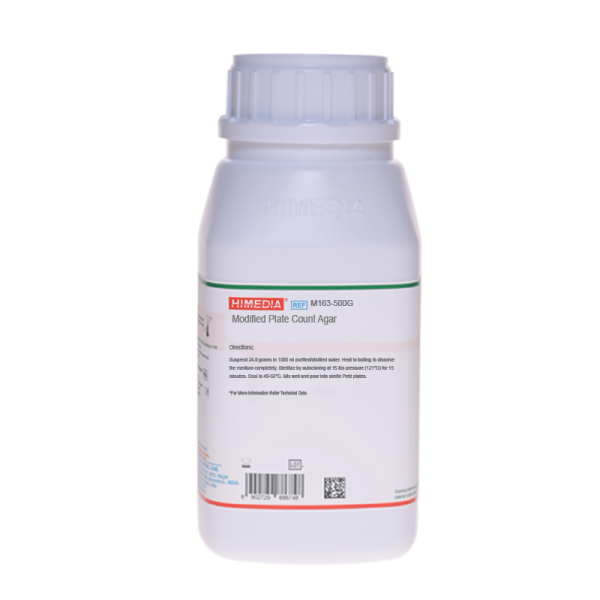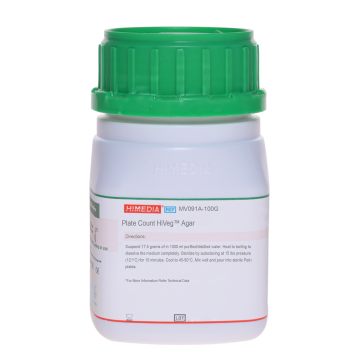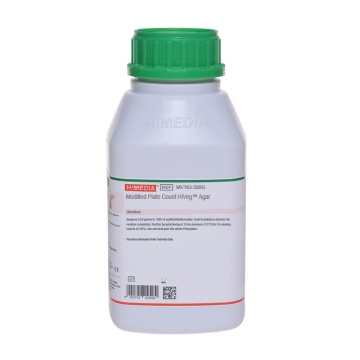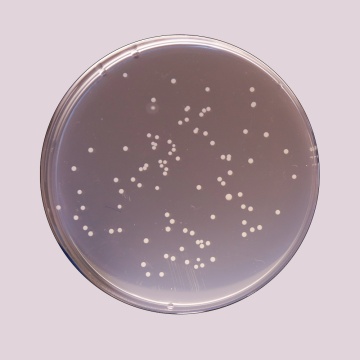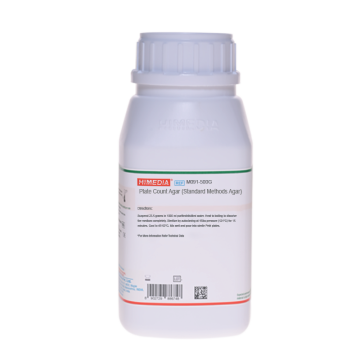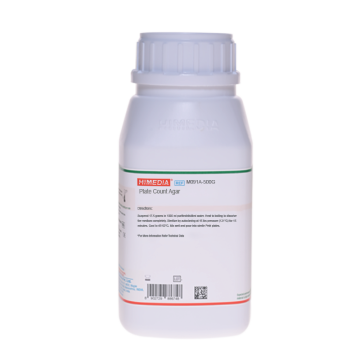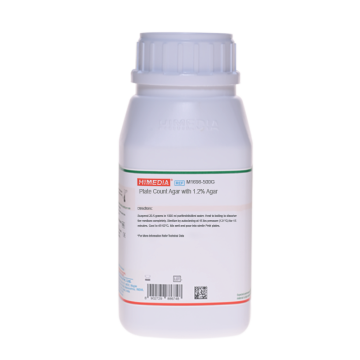 Your enquiry has been submitted
Your enquiry has been submitted
Modified Plate Count Agar
Media for Bacteria#CC293D
Intended use
Recommended for enumeration of bacteria in milk and milk products, rinse waters, ice creams etc.
Composition**
| Ingredients | Gms / Litre |
|---|---|
| Peptone | 5.000 |
| Yeast extract | 3.000 |
| M-protein solids# | 1.000 |
| Agar | 15.000 |
Final pH (at 25°C): 7.2±0.2
**Formula adjusted, standardized to suit performance parameters
#- Equivalent to Milk solids
Directions
Suspend 24.0 grams in 1000 ml purified/ distilled water. Heat to boiling to dissolve the medium completely. Sterilize by autoclaving at 15 lbs pressure (121°C) for 15 minutes. Cool to 45-50°C. Mix well and pour into sterile Petri plates.
Principle And Interpretation
The milk secreted in an uninfected cow's udder is sterile. Contamination of this milk can occur during milking, cooling and storage (1). Milk is an excellent medium for bacteria, yeast and moulds. Their rapid growth can cause marked deterioration, spoiling the milk for liquid consumption or manufacture into dairy products. Human infection can occur by consumption of such contaminated milk or milk products. Milk Agar is recommended for performing plate count tests on milk, rinse waters and dairy products. It is formulated as per the official medium described by Department of Health Memo (3). It is also recommended by EUROGLACE (EEC Ice Cream Industries) for the examination of ice cream (3).
Peptone and yeast extract provide essential nutrients while M-Protein solids are a source of casein. Dextrose is the carbon and energy source. Proteolytic bacteria will be surrounded by a clear zone, due to the conversion of casein into soluble nitrogenous compounds (7).
For milk, dilutions of 1/10, 1/100 and 1/1000 are prepared with 1/4 strength Ringer solution. 1 ml of each dilution is pipetted aseptically into sterile Petri plates to which 10 ml of sterile and cooled Milk Agar is added and mixed well. Plates should be poured within 15 minutes of dilution preparation. After solidification of medium the plates are allowed to stand for 1 hour before transferring to the incubator. Incubate at 35°C for 2 or 3 days at 30°C. Higher counts may be obtained after an incubation at 22°C and 30°C temperature rather than at 35°C (5, 6, 7). Count the colonies within 4 hours after the incubation and read it as per ml of sample.
Type of specimen
Milk and milk products, rinse waters, ice creams etc.
Specimen Collection and Handling
For milk and dairy samples, follow appropriate techniques for sample collection and processing as per guidelines (2,8,9). After use, contaminated materials must be sterilized by autoclaving before discarding.
Warning and Precautions
Read the label before opening the container. Wear protective gloves/protective clothing/eye protection/ face protection. Follow good microbiological lab practices while handling specimens and culture. Standard precautions as per established guidelines should be followed while handling specimens. Safety guidelines may be referred in individual safety data sheets.
Limitations
- Due to nutritional variations, some strains may show poor growth.
Performance and Evaluation
Performance of the medium is expected when used as per the direction on the label within the expiry period when stored at recommended temperature.
Quality Control
Appearance Cream to yellow homogeneous free flowing powder
Gelling Firm, comparable with 1.5% Agar gel
Colour and Clarity of prepared medium Light yellow coloured slightly opalescent gel forms in Petri plates
Reaction Reaction of 2.4% w/v aqueous solution at 25°C. pH : 7.2±0.2
pH 7.00-7.40
Cultural Response Cultural characteristics observed after an incubation at 35 - 37°C for 18 - 48 hours.
| Organism | Inoculum (CFU) | Growth | Recovery |
|---|---|---|---|
| Bacillus subtilis subsp. spizizenii ATCC 6633 (00003*) | 50-100 | good-luxuriant | >=70% |
| Pseudomonas aeruginosa ATCC 27853 (00025*) | 50-100 | good-luxuriant | >=70% |
| Lactobacillus casei ATCC 9595 | 50-100 | good-luxuriant | >=70% |
| Staphylococcus aureus subsp. aureus ATCC 25923 (00034*) | 50-100 | good-luxuriant | >=70% |
| Serratia marcescens ATCC 8100 | 50-100 | good-luxuriant | >=70% |
*- Corresponding WDCM numbers
Storage and Shelf Life
Store between 10-30°C in a tightly closed container and the prepared medium at 2-8°C. Use before expiry date on the label. On opening, product should be properly stored dry, after tightly capping the bottle in order to prevent lump formation due to the hygroscopic nature of the product. Improper storage of the product may lead to lump formation. Store in dry ventilated area protected from extremes of temperature and sources of ignition Seal the container tightly after use. Use before expiry date on the label. Product performance is best if used within stated expiry period.
Disposal
User must ensure safe disposal by autoclaving and/or incineration of used or unusable preparations of this product. Follow established laboratory procedures in disposing of infectious materials and material that comes into contact with clinical sample must be decontaminated and disposed of in accordance with current laboratory techniques (4,5).
Reference
- Collee J. G., Fraser A. G., Marimon B. P., Simmons A., (Eds.), Mackie and McCartney, Practical Medical Microbiology, 1996, 14th Edition, Churchill Livingstone.
- Davis J. G., 1959, Milk Testing, 2nd Ed., Dairy Industries Ltd., London, Pg. 175.
- Dept. of Health, 1987, Memo. 139/Foods.
- Isenberg, H.D. Clinical Microbiology Procedures Handbook. 2nd Edition.
- Jorgensen, J.H., Pfaller, M.A., Carroll, K.C., Funke, G., Landry, M.L., Richter, S.S and Warnock., D.W. (2015) Manual of Clinical Microbiology, 11th Edition. Vol. 1.
- Klose J., 1968, Susswaren, 14:778.
- Methods of Microbiological Examination for Dairy Purposes, Diluents, Media and Apparatus and their Preparation and Sterilization, BS4285, Sec. 1.2.
- Thomas S. B. and Jenkins E., 1940, Proc. Soc. Appl. Agric., 38:40.
- Wilson G. S., 1935, Bacteriological Grading of Milk, HMSO, London.
| Product Name | Modified Plate Count Agar |
|---|---|
| SKU | M163 |
| Product Type | Regular |
| Physical Form | Powder |
| Origin | Animal |
| Packaging type | HDPE |
| References | 1. Collee J. G., Fraser A. G., Marimon B. P., Simmons A., (Eds.), Mackie and McCartney, Practical Medical Microbiology,1996, 14th Edition, Churchill Livingstone. 2.Dept. of Health, 1987, Memo. 139/Foods. 3.Klose J., 1968, Susswaren, 14:778. 4.Methods of Microbiological Examination for Dairy Purposes, Diluents, Media and Apparatus and their Preparation andSterilization, BS4285, Sec. 1. 2.. Davis J. G., 1959, Milk Testing, 2nd Ed., Dairy Industries Ltd., London, Pg. 175. 6.Thomas S. B. and Jenkins E., 1940, Proc. Soc. Appl. Agric., 38:40. 7.Wilson G. S., 1935, Bacteriological Grading of Milk, HMSO, London. 8.Isenberg, H.D. Clinical Microbiology Procedures Handbook. 2nd Edition. 9.Jorgensen,J.H., Pfaller , M.A., Carroll, K.C., Funke, G., Landry, M.L., Richter, S.S and Warnock., D.W. (2015)Manual of Clinical Microbiology, 11th Edition. Vol. 1. |
| Customized Product Available | No |



